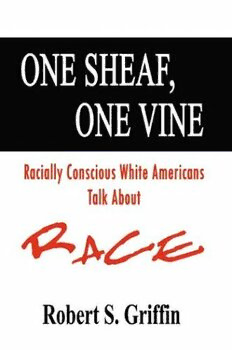
One Sheaf, One Vine: Racially Conscious White Americans Talk About Race PDF
173 Pages·2004·0.856 MB·English
Most books are stored in the elastic cloud where traffic is expensive. For this reason, we have a limit on daily download.
Preview One Sheaf, One Vine: Racially Conscious White Americans Talk About Race
Description:
Society tends to make any serious discussion of race issues taboo. This subject of race is almost always framed within terms of political correctness or with light criticism inputs from 'conservatives' who themselves self-censor too much. Thus, there just is no real dialogue on this.
I think this is really sad and even dangerous, as America is dramatically changing demographically and turning from a majority-white nation, into a majority-non-white nation, and the more we discuss race as seriously and factualy as possible, the better. But it just isn't happening.
Mass media tends to present racists as solely white, and as a bunch of freaks and nuts. The former presumption is completely untrue of course as so many blacks, mexicans, etc. are blatantly and violently and outspokenly racist. The latter is sadly at least sometimes true, as is seen with drunken, badly-behaved 'skinheads' and a wild assortment of mentally unbalanced or costumeried freaks who adore getting their images on the nightly news. So, the negative stereotype portrayed, does have at least some truth to it.
But in this unusual book, Professor Griffin interviewed a small sampling of serious racially conscious white men and women and discussed with them how they become interested in this and what made them into racialists, their activities and plans, and so on. These are fairly ordinary mainstream people, none of whom have any power of influence, thus the utility of a work like this is to serve to reveal some sociological or psychological insights perhaps.
One interesting observation I obtained from reading this, is that most of the people profiled in the book have no children at all or only one child. This is ironic, as they all complain about the demographic changes and the takeover of America by blacks, mexicans, etc. - ethnic and racial groups that have very high birthrates. So, the people profiled are themselves a major part of the very problems and changes they are inveighing against.
Another observation I make, is that none of the people in the book, offer any solutions to the racial problems they criticize. In numerous cases, they simply flee those high-'diversity' problems by moving to other, whiter states. But none of them seem to envision the new domiciles undergoing future change.
Well, at least these people point out the problems themselves. That's something. In our society, that is a major move forward. Perhaps a future book by Professor Griffin will discussed various ideas and theories as to possible solutions - if there ARE any, a major IF.
See more
The list of books you might like
Most books are stored in the elastic cloud where traffic is expensive. For this reason, we have a limit on daily download.
